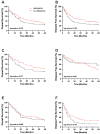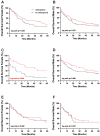Perioperative and Oncological Outcome in Patients Undergoing Curative-Intent Liver Resection for Cholangiocarcinoma in the Context of Osteopenia
- PMID: 40647511
- PMCID: PMC12248797
- DOI: 10.3390/cancers17132213
Perioperative and Oncological Outcome in Patients Undergoing Curative-Intent Liver Resection for Cholangiocarcinoma in the Context of Osteopenia
Abstract
Background: Cholangiocarcinoma (CCA) of the liver is a highly aggressive cancer that arises from malignant cells in the bile ducts. Radical surgery remains the only curative option, but major liver resection carries high perioperative risks. This study investigates the predictive value of preoperative bone mineral density (BMD), measured via CT, for perioperative complications, mortality, and long-term outcomes. Methods: The analysis included 202 patients who underwent curative-intent surgery for intrahepatic cholangiocarcinoma (iCCA; n = 97) or perihilar cholangiocarcinoma (pCCA; n = 105) between 2010 and 2019. Preoperative bone mineral density (BMD) was assessed using computed tomography segmentation at the level of the 12th thoracic vertebra. Osteopenia was defined according to established cutoffs. Results: Osteopenia was highly prevalent in both iCCA (53/97, 54%) and pCCA (54/105, 51%) subcohorts. Patients suffering from osteopenia were significantly older than those without (71.1 [62-76.6] years vs. 61.3 [52.9-69.2] years; p < 0.001). Alteration in BMD did not demonstrate a significant prognostic effect in terms of perioperative morbidity (Mann-Whitney U; comprehensive complication index-CCI: 34 [9-56] vs. 40 [21-72] p = 0.185; iCCA: p = 0.803; pCCA: p = 0.165). The median overall survival in our cohort was 19 [14-25] months. Patients with osteopenia did not exhibit a significantly different overall survival compared to those with normal bone mineral density (log-rank p = 0.234). Conclusions: In contrast to our previous observations in other oncological patient cohorts, osteopenia alone had no significant negative impact on clinical outcomes in our large European cohort of patients undergoing curative-intent surgery for CCA. To validate these findings, further prospective studies are warranted.
Keywords: CCA; body composition; bone mineral density; liver resection; osteopenia.
Conflict of interest statement
The authors of this manuscript have no conflicts of interest to disclose.
Figures




References
-
- Montano-Loza A.J., Angulo P., Meza-Junco J., Prado C.M.M., Sawyer M.B., Beaumont C., Esfandiari N., Ma M., Baracos V.E. Sarcopenic obesity and myosteatosis are associated with higher mortality in patients with cirrhosis. J. Cachex-Sarcopenia Muscle. 2015;7:126–135. doi: 10.1002/jcsm.12039. - DOI - PMC - PubMed
-
- Czigany Z., Kramp W., Bednarsch J., van der Kroft G., Boecker J., Strnad P., Zimmermann M., Koek G., Neumann U.P., Lurje G. Myosteatosis to predict inferior perioperative outcome in patients undergoing orthotopic liver transplantation. Am. J. Transplant. 2019;20:493–503. doi: 10.1111/ajt.15577. - DOI - PubMed
LinkOut - more resources
Full Text Sources

